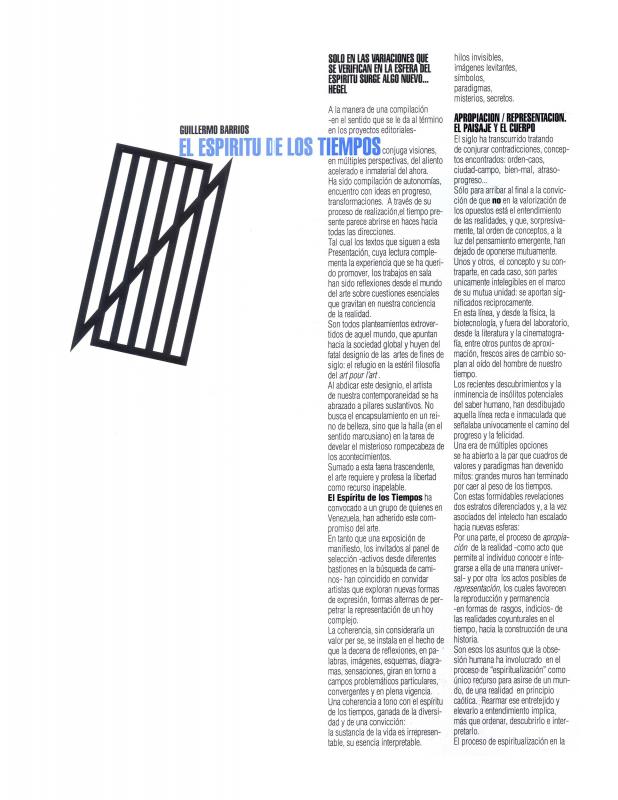The exhibition El espíritu de los tiempos, organized by the Ateneo de Caracas to celebrate its sixtieth anniversary [in 1991], is representative of the Conceptual and Neo-Conceptual designs developed in Venezuela during the 1990s. Organized by the curator Guillermo Barrios, this exhibition invited each of five well-known Venezuelan curators and critics to make a selection of one or two artists and to write an essay about their chosen artist(s). Starting with an introduction by Barrios [see ICAA digital archive, “El espíritu de los tiempos” (doc. No. 1160984)] and this essay by Graciela Pantin, “Reflexiones en torno a la contemporaneidad en las artes visuales venezolanas: 4 minutos para mirar, una obra de Susana Amundaraín y Xiomara Moreno,” the catalogue also includes several other texts: one by Zuleiva Vivas (on Claudio Perna) (doc. No. 1065674); an essay by Ariel Jiménez (on José Gabriel Fernández) (doc. No. 1097294); and finally, one by María Elena Ramos (on José Antonio Hernández Diez) (doc. No. 1065692)]. The curator Miguel Miguel selected the artist Alfred Wenemoser but declined to write an essay.
This essay by the Venezuelan curator and arts manager Graciela Pantin provides an important summary of the parameters that characterize the Post-modern period. These parameters are shown both in the essay’s theoretical content and in the organized way it presents ideas. The writer believes that the ideas here summarized affect the interdisciplinary nature of today’s artist. As opposed to other writers for this catalogue, Pantin made no attempt to investigate the possible significance, whether philosophical or humanistic, of what might be seen as the Espíritu de los Tiempos (Zeitgeist], in the sense of that inherent in humankind throughout time. Instead, she limited herself to the spirit of “these times,” of art and humans in the late twentieth century.
The mere fact of selecting two artists from different art worlds, Susana Amundaraín (b. 1954), visual arts, and Xiomara Moreno (b. 1960), theatrical arts, allows her to delve into interdisciplinary issues. This also opens the way to other contemporary art problems based on both the interaction of languages and the broad field for thinking and expression available to the artists of the day. Thus, Pantin presents a number of changes that have occurred in the world and are affecting artists of the times. Examples are: the loss of faith in progress; the loss of the sense of linear progress in history; the failure of avant-garde movements; our inability to differentiate between an original and a copy; the prevalence of the concept as an instrument for learning about reality; the accelerated pace of change in visual communications media and technology; the internationalization of art activities; and the intervention of market forces in the meaning of art.




